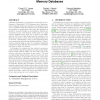Free Online Productivity Tools
i2Speak
i2Symbol
i2OCR
iTex2Img
iWeb2Print
iWeb2Shot
i2Type
iPdf2Split
iPdf2Merge
i2Bopomofo
i2Arabic
i2Style
i2Image
i2PDF
iLatex2Rtf
Sci2ools
132
Voted
SIGMOD
2010
ACM
2010
ACM
Low overhead concurrency control for partitioned main memory databases
Database partitioning is a technique for improving the performance of distributed OLTP databases, since “single partition” transactions that access data on one partition do not need coordination with other partitions. For workloads that are amenable to partitioning, some argue that transactions should be executed serially on each partition without any concurrency at all. This strategy makes sense for a main memory database where there are no disk or user stalls, since the CPU can be fully utilized and the overhead of traditional concurrency control, such as two-phase locking, can be avoided. Unfortunately, many OLTP applications have some transactions which access multiple partitions. This introduces network stalls in order to coordinate distributed transactions, which will limit the performance of a database that does not allow concurrency. In this paper, we compare two low overhead concurrency control schemes that allow partitions to work on other transactions during network sta...
Concurrency Control | Database | SIGMOD 2010 | Speculative Concurrency Control | Traditional Concurrency Control |
| Added | 18 Jul 2010 |
| Updated | 18 Jul 2010 |
| Type | Conference |
| Year | 2010 |
| Where | SIGMOD |
| Authors | Evan P. C. Jones, Daniel J. Abadi, Samuel Madden |
Comments (0)

